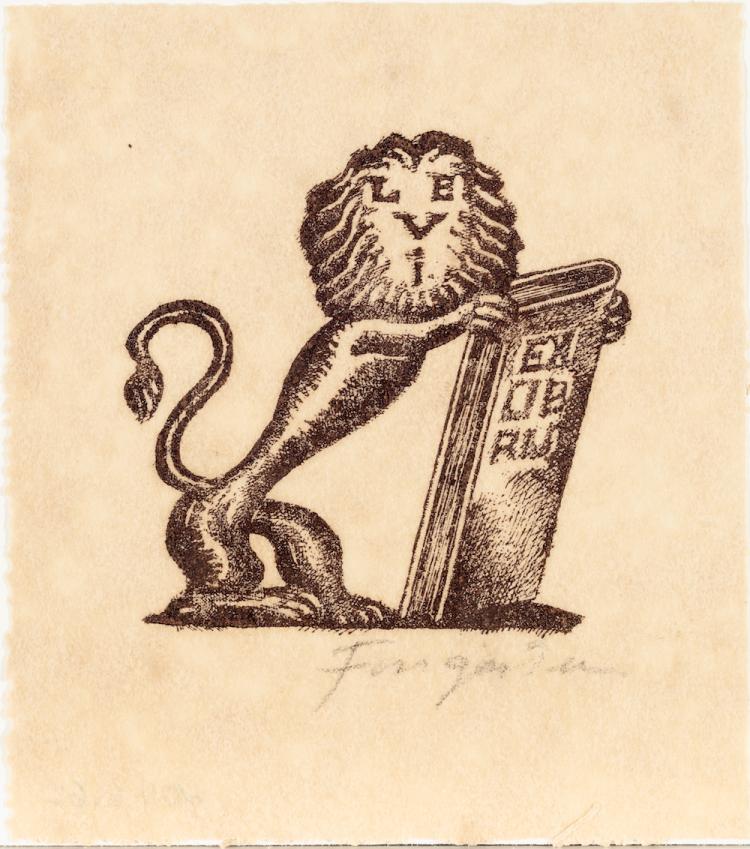The Fingesten Collection
Michel Fingesten was born Michl Finkelstein in 1884 in the village of Buckovice (Buczkowitz), Silesia, in the Habsburg Empire, now part of the Czech Republic, from a Czech-Jewish father and an Italian-Jewish mother, and died in 1943 in Cerisano, Calabria, after the liberation by the allies of the camp in which he had been interned since 1941. He was one of the most original and productive graphic artists and bookplates designers of the twentieth century.

Fingensten was especially popular as a creator of bookplates or ex-libris (the Latin term meaning "From the books of…"), a genre that appealed to the taste of elites in the late 19th and early 20th century. Fingesten’s ingenuity was boundless even while working within severe spatial restraints, as the bookplates were usually pasted on the inside front cover of the collector’s books. In Fingesten’s hands, the bookplate transcends its utilitarian and decorative function and claims our attention as an independent work of art.
The university acquired in 2011 a large collection of Fingesten’s works, including 154 items, which had been assembled by an unknown collector, possibly Fridolf Johnson, bibliophile and editor of the American Artist Magazine for several years. Purchased with funds generously provided by the Program in Jewish Studies, the Fingesten Collection is now part of the CU Art Museum’s Permanent Collection. The selection has since grown with the purchase of a full set of ten extraordinary etchings, the 1916 series 10 Eaux-Fortes de genre phantastique, symbolique, grotesque, lyrique, satyrique, tragique sur des motifs érotiques (10 Etchings of the Fantastic, Symbolic, Grotesque, Lyrical, Satirical, Tragic Genre on Erotic Motives).
Fingesten’s inspiration shifted throughout his career between the erotic and the political. Especially in the years leading up to WWII, Fingesten’s work takes on a new, almost prophetic tone in denouncing the dangers of the impending catastrophe. And yet, in spite of his tragic life and times, despair is never the last word in Fingesten’s work. His stoicism is best summed up in the motto for a 1939 bookplate: “Better to die on one’s feet than to live on one’s knees (Meglio morire in piedi che vivere in ginocchio).”
There is still much work to be done on Fingesten, both on his biography and his art, and the purchase of this collection allows scholars at CU to engage in pioneering research and bring due recognition to this extraordinary artist.
- Michael Fingesten, Austrian | Czech (1884-1943), Ex Libris Livio Ghislandi, 20th century, etching, 3 15/16 x 5 1/2 inches. Purchased with funds from the Jewish Studies Department, CU Art Museum, University of Colorado Boulder, 2011.06.13. Photo: Jeff Wells, © CU Art Museum.
- Michael Fingesten, Austrian | Czech (1884-1943), Ex Libris Marco Birnholz, 20th century, etching, 5 3/8 x 3 5/8 inches. Purchased with funds from the Jewish Studies Department, CU Art Museum, University of Colorado Boulder, 2011.06.140. Photo: Jeff Wells, © CU Art Museum.
Body Image
- Michael Fingesten, Austrian | Czech (1884-1943), Ex libris Levi, 20th century, etching, 4 ½ x 4 inches. Purchased with funds from the Jewish Studies Department, CU Art Museum, University of Colorado Boulder, 2011.06.62. Photo: Jeff Wells, © CU Art Museum.

